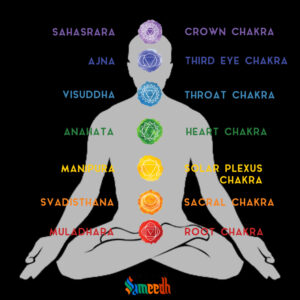The Manipur chakra, also known as the solar plexus chakra, is one of the seven main energy centers in the body according to Hindu and Buddhist teachings. It is located at the solar plexus, just above the navel, and is associated with the element of fire. The manipur chakra is believed to govern our personal power, self-esteem, and sense of purpose.

- Location: Upper abdomen, near the stomach
- Color: Yellow
- Element: Fire
- Significance: Governs personal power, confidence, and digestion.
- Deity: Manipur is often associated with the god Rudra, a fierce form of Shiv, symbolizing the transformative and destructive aspects of fire.
The Manipur Chakra, commonly known as the Solar Plexus Chakra, is the third primary chakra in Hinduism in 7 Chakras. It is associated with personal power, self-esteem, confidence, and the transformative energy of fire.
The Manipur Chakra is located in the upper abdomen, near the stomach, and is often associated with the solar plexus region. The traditional color associated with the Solar Plexus Chakra is yellow, symbolizing warmth, energy, and vitality. The symbol of the Manipur Chakra is a ten-petaled lotus flower. Each petal is associated with different qualities related to the chakra. The element associated with the Manipur Chakra is fire. This element represents transformation, willpower, and the ability to overcome obstacles.
The Manipur Chakra is considered the center of personal power, self-esteem, and confidence. It is associated with the transformative and purifying qualities of fire, symbolizing the ability to burn away impurities and obstacles. Manipur is often associated with the god Rudra, a fierce form of Shiv. Rudra embodies the transformative and destructive aspects of fire, representing the power of regeneration and renewal.
When this chakra is balanced and open, it is believed to give us a strong sense of personal power and the ability to achieve our goals. On the other hand, if the manipur chakra is blocked or imbalanced, it can lead to feelings of low self-esteem, a lack of confidence, and a lack of purpose in life.
To balance and open the manipur chakra, some practices that may be helpful include:
Engaging in activities that help you build confidence and self-esteem, such as self-care practices or setting and achieving small goals.
Practicing yoga poses that focus on the upper abdomen and solar plexus, such as boat pose or cobra pose.
Using essential oils or crystals that are associated with the solar plexus chakra, such as lemongrass or citrine.
Visualizing the color yellow or the symbol of the manipur chakra to help bring awareness and energy to this chakra.
The Manipur Chakra serves as a bridge between the lower chakras associated with more earthly concerns and the higher chakras related to spiritual consciousness. Its proper functioning contributes to overall chakra system harmony.
Balancing the Solar Plexus Chakra is considered essential for a healthy sense of self, personal empowerment, and the ability to manifest one’s desires. Practices that focus on building confidence, setting and achieving goals, and embracing personal power can contribute to the harmonious functioning of the Manipur Chakra.
